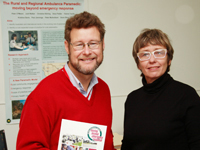 It is no secret that inland Australia is suffering from a chronic shortage of health workers. Charles Sturt University (CSU) researchers have found that in some regional areas, rural ambulance paramedics are already evolving innovative practises to becoming front line primary health care providers.
It is no secret that inland Australia is suffering from a chronic shortage of health workers. Charles Sturt University (CSU) researchers have found that in some regional areas, rural ambulance paramedics are already evolving innovative practises to becoming front line primary health care providers.Peter O'Meara, Associate Professor in CSU’s School of Public Health, says the recent research report, Moving Beyond Emergency Response, has so far been very well received. “It is having quite an impact,” he said.
Authors of Beyond Emergency Response Peter O'Meara and Vianne Tourle
“People are finding new ways of doing things. The models we found in Victoria and South Australia are expanding the roles of paramedics more into the community. In South Australia, in particular, they had a problem and someone came up with a solution.
“A paramedic was visiting a relative in a small town. He got talking to the local Director of Nursing, who was complaining about how tough life was when there were no doctors. If the doctors were away for a few days it left the nursing staff feeling very, very exposed. The ambulance service was able to support them in that way.
“No one is suggesting ambulance officers replace doctors. The ambulance service’s own medical officer provides some authority, support and advice. It has worked very well.
“It has impacted on the volunteer ambulance services that were in those towns because they are now getting more support, and they feel more valued and a lot more confident. All the projects we have examined in our report have lifted the profile of the ambulance service enormously. In Tasmania and Victoria they have become real community leaders. It is a very positive project.”
It is working so well that the New South Wales Ambulance Service is now moving forward along the same lines, according to Professor O’Meara.
“We knew these things were happening but they’d never been captured or acknowledged. One big thing to come out of the project is that the states are actually talking to each other and acknowledging that there is a possibility other people are doing it better. They are learning from each other.”
Professor O’Meara says the local “ambo” was once very much part of small regional communities. “Ambulance services were originally based around small towns with local management committees. Now they tend to be State-wide services with big bureaucracies. Local people feel a bit estranged from this larger organisation.
“In a sense it is back to the future. Ambulance services have become more professional over time and they have moved away from the community links that they originally had. They now have to re-establish those links.”





Social
Explore the world of social